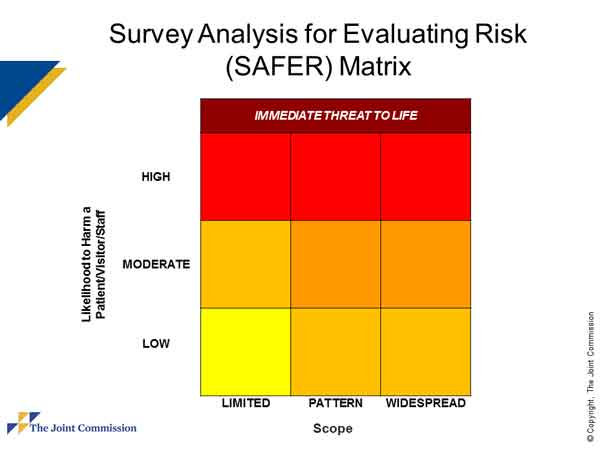In recent newsletters, we’ve been keeping you updated on changes to the scoring methodology and survey process for psychiatric hospitals that use TJC accreditation for deemed status. (See our March and April newsletters.) As previously discussed, the changes to the scoring methodology are effective for psychiatric hospitals as of June 6, 2016. TJC has now formally announced that these changes will go into effect for all other accreditation programs (including Behavioral Health) effective January 1, 2017.
The following is a summary of the key changes that will impact your survey reports and your post-survey follow-up.
SAFER Matrix
The most significant change to survey reports is that they will include a new matrix summarizing the survey findings based on the estimated level of risk to patients/clients, staff, and visitors. The matrix is titled SAFER (Survey Analysis for Evaluating Risk). The SAFER matrix will be displayed as a 9 box grid summarizing the survey findings based on the following factors:
- Likelihood of harm (low, moderate, high)
- Scope of non-compliance (limited, pattern, widespread)

An example of a finding that might be scored in the lower left corner of the grid (low risk) would be one medical record that lacked a statement of the client’s goals in his/her own words. A finding that might be scored in the upper right corner (high risk) would be absence of a suicide risk assessment in multiple programs across the organization.
The purpose for using this new matrix is to provide organizations with a high level analysis of the degree of risk represented by the various survey findings. It’s designed to aid leadership in identifying and prioritizing those findings that present the greatest risk of harm. One obvious question is “What about findings that fall in the high risk/red zone category?” First, these findings should become a high priority for leadership to understand and address. In terms of the response to TJC on these types of findings, there will be an additional level of detail required on the Evidence of Standards Compliance (ESC) response. TJC is in the process of defining what that will entail.
In addition to the SAFER matrix, the following changes will go into effect for all accreditation programs effective January 1, 2017:
- There will no longer be Direct Impact and Indirect Impact findings and elements of performance.
- Elements of performance will no longer be categorized as A or C.
- There will be no category of “Opportunities for Improvement” which currently do not require a response. All findings (including single instances of non-compliance) will be included in the survey report and will require a response. (This approach emanates from the CMS position: “If you see it, you cite it.”)
- There will be no 45 vs. 60 day ESC responses in follow-up to surveys. All responses will be due 60 days after the official survey report is posted.
- Measure of Success (MOS) data will no longer be required as part of the ESC response. Instead, those findings rated at the higher risk level on the SAFER matrix will require a plan describing how compliance with the applicable standard will be achieved and sustained.
To read TJC’s announcement of the new SAFER matrix and changes to the scoring methodology, see the May 2016 issue of TJC Perspectives which is available to accredited organiztions through their TJC Connect site.

